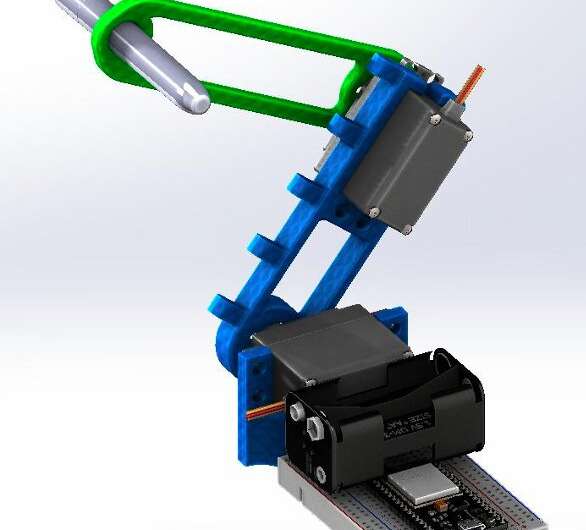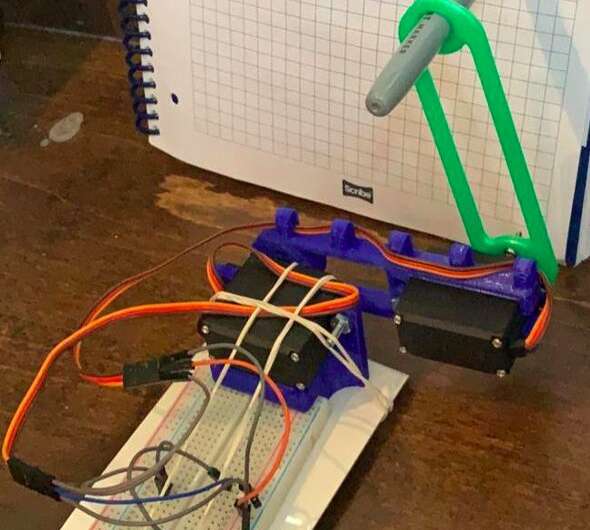December 14, 2020 feature
An open-source and low-cost robotic arm for online education

Researchers at Tecnologico de Monterrey in Mexico have recently created a low-cost robotic arm that could enhance online robotics education, allowing teachers to remotely demonstrate theoretical concepts explained during their lessons. This robotic arm, presented in a paper published in Hardware X, is fully open source and can be easily assembled by all teachers and educators worldwide.
"This project began during the COVID-19 outbreak back in March 2020," Victor H. Benitez, one of the researchers who carried out the study, told TechXplore. "After learning about direct and inverse kinematics and its applications, two students, Rodrigo Symonds and David Elguezabal, came to me with the idea of creating a two-link robotic arm with IoT capabilities as a project for their robotics class."
Benitez and his students set out to create an affordable robot that could be assembled outside of laboratory environments (i.e., without the need for advanced tools and equipment), but that could be used to showcase complex robotics concepts in a physical environment. An example of these concepts is kinematics, a mathematical process underpinning the movements of robots that can be difficult for students to understand when is only theoretically explained to them (i.e., without any physical demonstrations).
"Our robotic arm uses a mathematical process called kinematics," Benitez explained. "Direct kinematics consists of using matrices with the desired joint angle values to determine the position of the end effector. We used the Denavit-Hartenberg convention to implement this behavior in the robot. On the other hand, indirect kinematics are mainly trigonometric equations that create relations between lengths and angles to calculate how the joints of the arm need to move for the end effector to reach a given point or trajectory in space."
The trajectory that a robotic arm needs to follow to move an end effector (i.e., an object of interest) to a specific place is determined by specific coordinates or parametric functions. In this context, the end effector could be any object that the arm is trying to move, such as a marker pen, a laser or even a robotic gripper.

In contrast with other existing robotic arms, this arm has low production costs. It can also be connected to WiFi sources and can be controlled remotely via an online app. This makes it ideal for remote learning, as it allows teachers and students who are communicating over the internet to experiment with the same arm. In addition, the program it is based on allows users to easily access every command and parameter behind the arm's movements, which can further support learning and enhance each student's understanding of the processes underpinning a robot's behavior.
The robotic arm has four key components: an electromechanical arm structure, a control system, a wi-fi communications module and a human-machine interface. It is entirely open source and modifiable, which means that educators worldwide can access its design and adapt it according to their specific needs. Using this arm, teachers can demonstrate many robotics concepts, but also touch on other topics related to mathematics, 3-D printing, computer science and programming.
"Our robot was primarily designed for educational purposes," Benitez said. "Educators can easily use and modify the robotic arm to teach students about the applications of the many topics mentioned in their lessons, even when facing the difficulties of online education."
The recent work by Benitez and his students shows that building a useful and efficient robot using affordable electronic components and actuators is possible. When the researchers evaluated their robotic arm, they found that it is a highly effective tool for demonstrating theoretical concepts, both in laboratory settings and remotely. Educators worldwide could soon start using it to teach students online in more engaging ways, providing tangible demonstrations of theoretical topics covered during lessons.
"Currently, a team of students is developing a second version of this robot with our help and recommendations," Benitez said. "They will implement upgrades to the robot and improve the performance and reliability of the original design without sacrificing its advantages (low price, IoT integration, educational purpose). We aim for a balance between price and usefulness to allow this project to be applied in many different ways."
More information: Design of an affordable IoT open-source robot arm for online teaching of robotics courses during the pandemic contingency. Hardware X(2020). DOI: 10.1016/j.ohx.2020.e00158.
© 2020 Science X Network

















